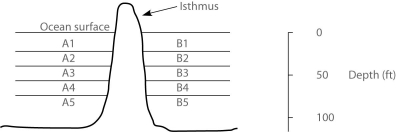The next few questions refer to the following description.
In the ocean, on either side of the Isthmus of Panama, are 30 species of snapping shrimp; some are shallow-water species, others are adapted to deep water. There are 15 species on the Pacific side and 15 different species on the Atlantic side. The Isthmus of Panama started rising about 10 million years ago.
In the following figure, the isthmus separates the Pacific Ocean on the left (side A) from the Atlantic Ocean on the right (side B) . The seawater on either side of the isthmus is separated into five depth habitats (1-5) , with 1 being the shallowest.

-In which habitat should one find snapping shrimp most closely related to shrimp that live in habitat A4?
Definitions:
Synonymous Mutation
A genetic mutation that does not alter the amino acid sequence of a protein due to the redundancy of the genetic code, often considered silent mutations.
Amino Acid
The building blocks of proteins, consisting of a basic amino group, an acidic carboxyl group, and a unique side chain.
Codon
A sequence of three nucleotides which together form a unit of genetic code in a DNA or RNA molecule.
Homogenized
Made uniform or similar in composition or structure; often refers to milk that has been processed to distribute fat evenly.
Q9: Which of the following traits do archaeans
Q11: The role that humans play in artificial
Q15: Which of Darwin's ideas had the strongest
Q21: When does exon shuffling occur?<br>A) during splicing
Q23: Which enzyme was used to produce the
Q23: Which of the following describes plant virus
Q29: With respect to the sickle-cell allele, what
Q53: A swim bladder is a gas-filled sac
Q71: Where does tRNA #2 move to after
Q100: Entrepreneurs attempted, but failed, to harvest nuts